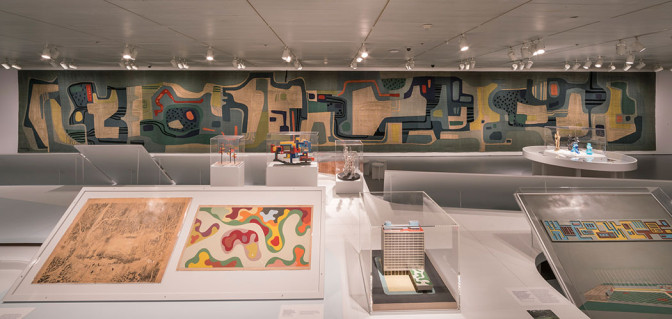Burle Marx and Re-imagining What Parks Can Be

Installation view of the exhibition. The Jewish Museum, NY. Photograph by David Heald.
On view at The Jewish Museum, NY, is the first US retrospective of the seminal landscape architect Roberto Burle Marx. Entitled “Roberto Burle Marx: Brazilian Modernist,” the exhibit is curated by Jens Hoffmann and Claudia Nahson and is on view through September 18th.The exhibit shows the breadth of Burle Marx’s artistic vision, his designs for jewelry, tapestries, sculptures, and drawings. With each medium, he added his dazzling touch to the Brazilian avant-garde movement. However, it was during his career as a landscape architect, beginning in the early 1930s, that Burle Marx produced his most ingenious designs. His modern designs for gardens, parks, and public spaces broke the rigid form of previous architectural schemas and his uncommon use of Brazil’s indigenous plants changed what was previously considered desirable in these spaces.
Both Burle Marx’s realized landscape designs, depicted in photographs at the exhibit, and proposed plans are spectacular works of modern art. Flat unmodulated planes vibrate with bright color. Shapes and patterns dance to the rhythm of abstraction. At the mineral roof garden, Banco Safra headquarters, for example, we can see a glistening testament to Burle Marx’s modernism. Colored pavement creates shapes of biomorphic abstraction that beat together in warm shades of sandy tan and deep ochre. Flora punctuates the schema like a painterly stroke, the texture of planted trees a comma in a well-written sentence.

Mineral roof garden, Banco Safra headquarters, São Paulo, 1983. Photograph by Leonardo Finotti.
Yet, it is on an additional level that Burle Marx’s landscape designs excel: in their spatial framing of our daily lives. His modernism functions in the extended field, interacting with the space of our bodies, the space that surrounds. Burle Marx’s constructed topographies unfurl in our experience of them. As we walk, dance, or wander through his designs, we relate to them with our full body. We are invited to sway in the sun with his swaths of colors, experience how it feels to touch the ground beneath us, to smell and hear what this new place is like. One of Burle Marx’s most well-known public projects is a design for a section two miles in length of Avenida Atlântica on the Copacabana beach promenade in Rio de Janeiro. In aerial shots of Burle Marx’s design, yellow taxis are accents to the curvilinear patterned pavements, adding movement and narrative. Pastel umbrellas dot the beach near the promenade, tiny figures forming clusters and dispersions. Their shadows fall behind them, adding waves upon the waves of his design. This is a lived space, one that fulfills the reciprocal invitation to change and be changed through our relation to a place.

Avenida Atlântica, Copacabana, Rio de Janeiro, 1970. Photograph by Burle Marx Landscape Studio.
Writing of public spaces, Burle Marx asserts that the “communal garden, square, or park will have increasing importance with time as we search for an acceptable equilibrium within the instability of our current civilization” (qtd. in Hoffmann, exhibition wall text, 2016). Poised between built and natural, landscape and architecture, theory and practice, Burle Marx puts into question our relationship with the natural world, the built environment, and further, our relationship with each other. It was his hope that by constructing environments that the public can relate to, Burle Marx’s designs would “repair the rift” between the built environment and the natural world (Hoffmann, exhibition wall text, 2016). His constructed landscapes use design to bring balance to our relationship with the natural world.
At Freshkills Park’s recent Discovery Day event, I stood on the field atop North Mound feeling the big swath of sky opening up above me. The air felt good. The open space did too. An open space that felt so surreal set against the Manhattan skyline in the distance. An open space that is entirely constructed, reclaimed, and remade. Perhaps this is a version of Burle Marx, I thought, an engineered paradise.
Approaching Freshkills Park through the lens of Burle Marx’s landscape architecture, I question how we may re-imagine what a park can be and what constitutes a built environment. Maybe if we lessen the dichotomy, the restriction between the built and natural, we can better understand what this space is: an engineered landscape, both built and natural, a space that intersects our daily life and one that is utterly apart from it. This is a space for the exploration of the poetic exchanges of self and geography, body and landscape, which comes from a deep connection to a place.
Written by Savannah Lust, Freshkills Park Development Intern.




